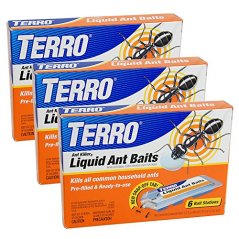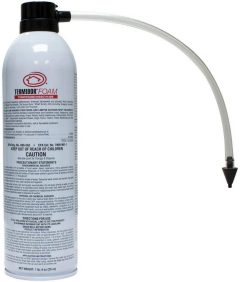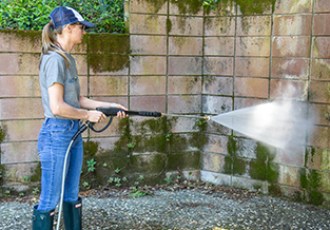BestReviews is reader-supported and may earn an affiliate commission. Details

User-friendly option that takes care of common household ant colonies.
User-friendly option that takes care of common household ant colonies.
Includes 12 bait stations that are easy to use and can be placed right away. Liquid Borax, the main ingredient, stays long enough for the ant to share the dose with the rest of the colony. Does not damage wooden floors or countertops.
Complete control may take up to 2 weeks.

A quick and efficient pesticide to remove problematic areas in the garden and home.
A quick and efficient pesticide to remove problematic areas in the garden and home.
Advanced bait combines food and water sources to deliver a lethal dose that can eliminate ants and their queens within hours. Can be used both indoors and outdoors. Has child-resistant stations, so it's family-friendly.
Some users reported that the package can leak if bumped the wrong way.

A natural, eco-friendly product that works on most insect pests.
A natural, eco-friendly product that works on most insect pests.
Can spray on fabrics, flooring, and furniture to stop the full pest life cycle. Made with natural ingredients, so it's safe for use in kitchens and around food prep materials. Has a pleasant smell.
Not the strongest product on the market. Spray doesn't seem to kill ants, just repel them.

Professional-strength pesticide originally used to kill termites, and now kills ants of all kinds.
Professional-strength pesticide originally used to kill termites, and now kills ants of all kinds.
A little goes a long way with this favorite in the pest control industry. Spray it around cracks and crevices for a long-term, residual impact. Works instantly. Termites can't smell or taste the formula.
Cannot be sprayed on food preparation surfaces, such as countertops or stoves.

Professional-bait pesticide targets harder-to-kill ant populations and large colonies.
Professional-bait pesticide targets harder-to-kill ant populations and large colonies.
Blend of ant lures and grit size will attract pests that are harder to control, including carpenter ants, acrobat ants, and harvester ants. Can be used sparingly on large colonies and nests. Effective for up to 3-5 years.
Product instructions are more complicated than other sprays or baits in the market.

We recommend these products based on an intensive research process that's designed to cut through the noise and find the top products in this space. Guided by experts, we spend hours looking into the factors that matter, to bring you these selections.

Everyone has had problems with ants at one time or another in their life, no matter where they live. Fortunately, ant killers can eradicate the infestation and prevent future invasions of your home.
Since ants originally have their anthills and colonies outside, keeping them out is the best strategy. Getting rid of them after they’ve made their way inside is harder. Once ants have gotten inside and let others in their colony know how to get there, your troubles are just beginning.
Ant killers come in the form of repellents and non-repellents, both of which can get ants out of the home. These products may be sprays, baits, or traps — and using them in conjunction can help put a stop to the infestation. The strength and active ingredients vary from one product to the next, so researching an ant killer before you buy one is important.

Before you choose an indoor ant killer, you should take a look at what kind of infestation you are dealing with so you can purchase a product that will work quickly and effectively.
Where are the ants coming in? If they’re entering through a ceiling joint, they’re probably gaining entrance to your home by crawling over a branch that is touching it. Alternately, they may follow power lines to the building.
If the ants are coming in at any point below the level of the ceiling, they’re probably getting in through a power outlet, a crack in the floor, window sills, or door frames.
If there are multiple trails of ants throughout the house, this doesn’t necessarily indicate multiple colonies gaining entrance. They could all be coming from one colony, especially if the entry points are on the same side of the house or building. If the entry points are on opposite ends of a house or long building, then you may be experiencing an invasion by multiple ant colonies.
Once you know what type of threat you are dealing with, you can find an indoor ant killer that is up to the job.
All insecticides fall into two basic categories: repellent and non-repellent. Each of them does exactly what the name would suggest, and both can be useful depending on your situation and the nature of your infestation
Repellents may be preventative or may be used to combat an ongoing infestation. These ant killers are designed to be detected by ants and encourage them to steer clear of your home. Once the ants have left, you can continue applying repellent to prevent future invasions.
Non-repellent insecticides don’t repel insects at all. Instead, they let them into the house, but the insecticide gets on them as they cross it since these products cannot be detected by ants. They begin to kill ants within a day or two after contact.
Bait
Using baits is the ideal method of treating ants in the home. This is because baits wipe out the entire colony, not just the individuals who come in contact with it. When ants find the bait, they carry it back to the colony, where it can get to work.
Trap
Ant traps don’t leave behind any chemical residue and are 100% effective against any ant that ventures into the sticky trap. Unfortunately, all ants won’t go into the trap, and those that don’t will be completely unaffected by it.
Spray
Ant spray has the fastest knock-down time of any method on the market. However, you’re always left with a residue of some kind, even if it’s invisible. Without the residue, there would be nothing to kill the ants. This means there will be a residue on your cabinets, floors, and wherever else you spray. It won’t be strong enough to hurt you, but you should be aware that it does exist — and you should wipe any sprayed areas clean after your ant problem is resolved.
The active ingredient in an insecticide is the one that actually kills the ants. The rest of the ingredients are carriers or have synergistic properties to enhance the effectiveness of the active ingredient. Common active ingredients are:
Most insecticides contain pyrethroids, synthetic versions of naturally occurring pyrethrins found in chrysanthemums. Pyrethroids have been used for decades, though many insects have become pyrethroid-resistant. There are hundreds of different kinds of pyrethroids, as manufacturers have tried to alter them just enough to work around the resistance insects have built up.
The other three active ingredients were first used for killing termites. Because termites and ants share many similarities, any active ingredient that can kill termites can also kill ants. However, it takes eight to ten years and expensive testing for the EPA to register an insecticide. In recent years, termiticides have begun making their appearance in ant-killing products.
EPA regulations are explicit and non-negotiable: insecticides are required by federal law to biodegrade within 90 days of application. As a result, 90 days is the absolute maximum that insecticides will be effective, and many last for considerably shorter periods.
The EPA registers all insecticides to ensure that they are not dangerous to use in the home. Because insecticides contain toxins, it is possible for them to be harmful if ingested. If you or someone in your home consumes insecticides, you should contact the Poison Control Center at 1 (800) 222-1222.
Some manufacturers offer products using essential oils such as peppermint, cedarwood oil, lemongrass oil, sesame oil, and other essential oils as their active ingredients. They are effective as cleaning products to erase the pheromone trails ants leave behind, but they are less effective at killing and repelling ants.
Products for under $10 have low concentrations of active ingredients and are unlikely to fully eradicate the ants in your home.
For $15 to $25, you will find more reliable options. You’ll also find some low-end professional-strength insecticides here. Products in this range have higher concentrations of active ingredients and can often prevent ants from re-entering your home.
Above $25 are professional-strength ant killers that are designed to tackle serious infestations. Some organic options fall into this range, as well as bulk options.

Q. Why can’t I spray insecticides on countertops?
A. This is a violation of EPA regulations for the intended use of ant killers. These sprays do contain toxins, which can easily make their way into your food if applied to food preparation surfaces.
Q. Can I spray inside an electrical socket?
A. Yes. As long as you don’t touch anything inside the socket, you’ll be fine — and you’ll eliminate a potential point of entry.
Q. Once the ants are gone, do I have to keep spraying?
A. You should spray at least once every 90 days as a preventative measure to keep the ants from coming back.
Get emails you’ll love.
Learn about the products you’re wondering if you should buy and get advice on using your latest purchases.
